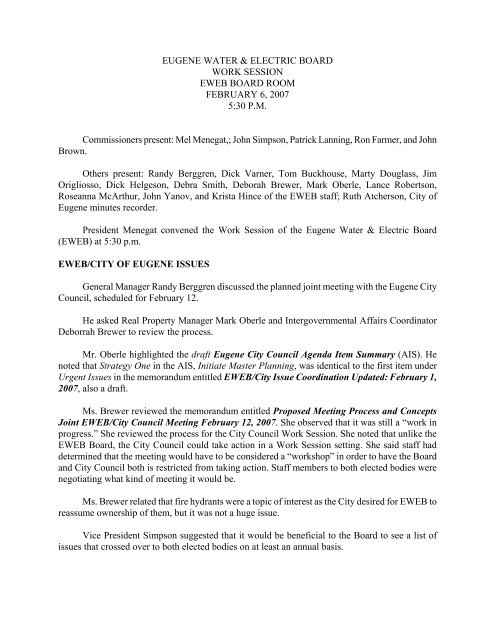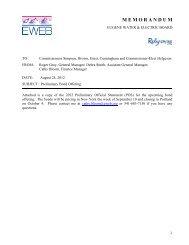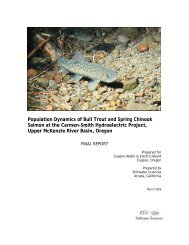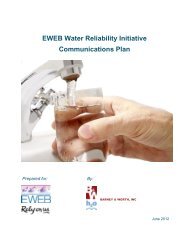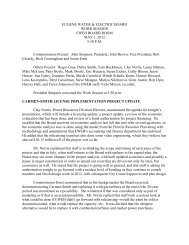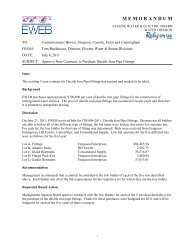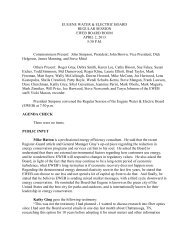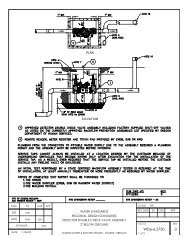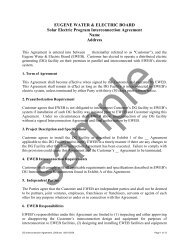Approval of Consent Calendar - Eugene Water & Electric Board
Approval of Consent Calendar - Eugene Water & Electric Board
Approval of Consent Calendar - Eugene Water & Electric Board
You also want an ePaper? Increase the reach of your titles
YUMPU automatically turns print PDFs into web optimized ePapers that Google loves.
EUGENE WATER & ELECTRIC BOARDWORK SESSIONEWEB BOARD ROOMFEBRUARY 6, 20075:30 P.M.Commissioners present: Mel Menegat,; John Simpson, Patrick Lanning, Ron Farmer, and JohnBrown.Others present: Randy Berggren, Dick Varner, Tom Buckhouse, Marty Douglass, JimOrigliosso, Dick Helgeson, Debra Smith, Deborah Brewer, Mark Oberle, Lance Robertson,Roseanna McArthur, John Yanov, and Krista Hince <strong>of</strong> the EWEB staff; Ruth Atcherson, City <strong>of</strong><strong>Eugene</strong> minutes recorder.President Menegat convened the Work Session <strong>of</strong> the <strong>Eugene</strong> <strong>Water</strong> & <strong>Electric</strong> <strong>Board</strong>(EWEB) at 5:30 p.m.EWEB/CITY OF EUGENE ISSUESGeneral Manager Randy Berggren discussed the planned joint meeting with the <strong>Eugene</strong> CityCouncil, scheduled for February 12.He asked Real Property Manager Mark Oberle and Intergovernmental Affairs CoordinatorDeborrah Brewer to review the process.Mr. Oberle highlighted the draft <strong>Eugene</strong> City Council Agenda Item Summary (AIS). Henoted that Strategy One in the AIS, Initiate Master Planning, was identical to the first item underUrgent Issues in the memorandum entitled EWEB/City Issue Coordination Updated: February 1,2007, also a draft.Ms. Brewer reviewed the memorandum entitled Proposed Meeting Process and ConceptsJoint EWEB/City Council Meeting February 12, 2007. She observed that it was still a “work inprogress.” She reviewed the process for the City Council Work Session. She noted that unlike theEWEB <strong>Board</strong>, the City Council could take action in a Work Session setting. She said staff haddetermined that the meeting would have to be considered a “workshop” in order to have the <strong>Board</strong>and City Council both is restricted from taking action. Staff members to both elected bodies werenegotiating what kind <strong>of</strong> meeting it would be.Ms. Brewer related that fire hydrants were a topic <strong>of</strong> interest as the City desired for EWEB toreassume ownership <strong>of</strong> them, but it was not a huge issue.Vice President Simpson suggested that it would be beneficial to the <strong>Board</strong> to see a list <strong>of</strong>issues that crossed over to both elected bodies on at least an annual basis.
Work SessionFebruary 6, 2007Page 2Commissioner Farmer asked that EWEB cease to refer to the riverfront property as “surplus”and to consider it to be “available” instead. He asked if EWEB believed it would have to conduct amaster plan process in order to gain a lot line adjustment. Mr. Oberle affirmed that it would.Commissioner Farmer asked if that would apply if EWEB utilized the land for itself.Mr. Oberle was uncertain <strong>of</strong> the answer.Commissioner Farmer said he would like to explore whether it would be required. He notedthat the AIS said the City Council had been told that the land was available and that the Council hadfive years to decide whether the City should purchase the property or not, but EWEB still had toundergo a master plan. He requested a legal opinion on this requirement. He added that he was infavor <strong>of</strong> telling the City sooner rather than later that the property was available.Intergovernmental Affairs Coordinator Deborrah Brewer said staff had tried to amend thewording so that it would not commit EWEB to anything at this point.Commissioner Lanning asked what the timeline would be to be able to make a formal motionon the recommendation. Mr. Berggren replied that the <strong>Board</strong> could take a motion at the nextmeeting, but he strongly recommended that the <strong>Board</strong> be very clear about what the motion would be.In response to a follow-up question from Commissioner Lanning, Mr. Berggren said he didnot think the <strong>Board</strong> would take formal action at the joint meeting. He thought the meeting wouldserve to gain common ground between the two elected bodies. He suggested the <strong>Board</strong> inquire as towhat the Council considered the word ‘value’ meant when referring to the property. He noted thatfor EWEB to “value” was primarily related to economics. He related that the Council was concernedabout the advisory committee and that the <strong>Board</strong> had not consulted them or proposed that anyCouncilor members participate in the process. He stressed that they had said as a concept EWEBwas open to whatever made the most sense apropos a master plan. He felt the <strong>Board</strong> should ascertainwhat the Council’s interest was in exercising their option on the property.Commissioner Lanning commented that it seemed that staff had done a good job in workingwith the City’s staff.Commissioner Farmer related that he had met with two councilors individually. He remarkedthat he would be disappointed if the council voted on a motion and the EWEB <strong>Board</strong> was notpermitted to. He underscored the necessity to hold a collaborative process. He averred that EWEBwould be “ill-served to jump into motions right away.” He hoped EWEB representatives wereencouraging the Mayor not to vote on anything at this time.Ms. Brewer said she would continue to work with the City’s staff, but she recommended the<strong>Board</strong> request that the council consider the meeting a “workshop.”President Menegat called for a ten-minute break.
Work SessionFebruary 6, 2007Page 3REGIONAL ISSUES UPDATEPower Resources Division Director Dick Helgeson provided a quarterly update on regionalissues with the aid <strong>of</strong> a power point presentation. He reviewed potential changes in the BonnevillePower Administration (BPA) power allocation to EWEB in 2011, when the EWEB contract wouldbe reviewed and renewed. He said the BPA document issued in July indicated that EWEB was likelyto be in a fairly balanced position in 2011. He noted that some <strong>of</strong> this would be a function <strong>of</strong> the loadbalancing circumstances in the region as a whole and projections <strong>of</strong> EWEB’s resource capability andload conservation over the next few years. He stated that there were multiple variables, most <strong>of</strong>which were out <strong>of</strong> the control <strong>of</strong> EWEB, such as load growth in the region as a whole, whether ornot there was a “re-rating” <strong>of</strong> individual utilities’ resource capabilities, or whether or not the BPAwould choose to serve <strong>of</strong> the direct service industries (DSIs) with firm power. He reiterated that staffintended to continue updating the analysis.Mr. Helgeson reported that EWEB was urging the BPA to begin to develop its methodologyfor power allocation as soon as possible. He said knowledge <strong>of</strong> the methodology would allow theutility to narrow the uncertainty regarding a contract after 2011. He stated that staff also requestedthat the process be iterative and transparent.Commissioner Farmer asked what it would mean financially if EWEB were balanced ratherthan long in four years. Mr. Helgeson responded that it could be good or bad. He said EWEB mayneed some <strong>of</strong> its undeclared resources to be dedicated to the load.Commissioner Farmer asked what the <strong>Board</strong> should think about in terms <strong>of</strong> action.Mr. Helgeson responded that EWEB should continue to move in the direction set forth in theIntegrated Energy Resource Portfolio (IERP) process, to move forward with lost opportunityacquisitions that EWEB was committed to. He stressed that EWEB’s objective was to do everythingpossible to find a balanced position, but it still had to recognize that EWEB would either buyadditional power out <strong>of</strong> Tier Two to cover load growth or it would be using the undeclaredresources.Fiscal Services Supervisor Dick Varner reported that EWEB had a 30-megawatt hour (MWH)long position with the BPA at present, at circa $30 per MWH, and it was selling it at circa $60 perMWH. He said the positive cash flow from this was over $20 million per year. He thought takingthis “out <strong>of</strong> the mix” would bring about a rate increase, estimated at being on the order <strong>of</strong> 5 to 10percent.Commissioner Farmer asked if the current strategy was sufficiently aggressive. Mr. Helgesonreplied that it would be tough to replace the revenue stream that had come from the BPA positionbecause EWEB would not be able to buy those resources elsewhere. He said part <strong>of</strong> the firm positionfrom the Slice share came from paying a fairly high average price per kilowatt hour because <strong>of</strong> thevariability in the volume <strong>of</strong> the secondary. He thought some <strong>of</strong> this might be mitigated by reducedrisk associated with having to manage the high volumes <strong>of</strong> secondary if EWEB chose a product that
Work SessionFebruary 6, 2007Page 4was not a Slice product. He noted that staff would be bringing the IERP decision “tree” back beforethe <strong>Board</strong> later in the year.Mr. Varner did not think there was a “silver bullet” that would allow EWEB to be in as good<strong>of</strong> a position in five years as it was in the present moment.Commissioner Farmer commented that a 10 percent rate increase to compensate for a changein the BPA allocation could come at the same time as the rate increase to pay for the Carmen-Smithrelicensing.Mr. Varner thought the mitigating factor down the line would be whether there were enoughcash reserves so that staff was willing to change its generation assumption.Mr. Helgeson affirmed that the <strong>Board</strong> was focused in the correct direction. He said from apower supply perspective, staff’s purpose over the next few years would be to figure out as clearlyas possible what the future power environment would look like. He reiterated that the presentsituation was driven by two questions: how much load growth would there be over the next severalyears and how successful would other utilities be in convincing the BPA to make changes to theresources it was currently obligated to bring to the load in the face <strong>of</strong> possible reductions in thesystem. He noted that there were some dams on the Snake River that could potentially be removedfrom the system.Regarding the BPA product design, Mr. Helgeson said the July proposal lacked specificitybecause it was a policy-level proposal. He reviewed the staff objectives, noting that EWEBpurchased 70 percent <strong>of</strong> its power from the BPA. He did not believe the BPA would continue toallow EWEB to take the long position it currently enjoyed. The staff objectives were, as follows:▪▪▪▪Retain the viability and flexibility <strong>of</strong> the Slice productAdvocate for a workable partial requirements productProtect the ability to meet loads, integrate resources, and access the marketsMaximize the portfolio value and competitiveness.In response to a question from Vice President Simpson, Mr. Helgeson explained that presentlyEWEB had the ability on the day power was being delivered to make modifications to its schedule,the advantage <strong>of</strong> which was that EWEB could flex its portfolio to deal with the load. He said EWEBcould respond to market conditions and could obtain a high value for it. He sensed the BPA desiredto lock in the schedule a day in advance.Commissioner Farmer asked if the utilities had a commonality <strong>of</strong> voice, or whether EWEBwas a minority view in its attempts to get information from the BPA and work with it. Mr. Helgesonreplied that about a third <strong>of</strong> the customers were actively engaged in the discussion. He noted thatsome utilities did not operate with any BPA power. He said there was a large group <strong>of</strong> fullrequirements customers as well. He felt their fear was that the utilities with their own means <strong>of</strong>
Work SessionFebruary 6, 2007Page 5generation would somehow take advantage <strong>of</strong> the system.Mr. Helgeson discussed the investor-owned utilities (IOUs) and the Residential ExchangeProgram, which required the BPA to make annual payments to the IOUs in order to mitigate theimpact on residential and farm customers the purchase <strong>of</strong> more expensive resources created. TheIOUs were not able to obtain firm power from the BPA pursuant to the passage <strong>of</strong> the NorthwestRegional Power Act <strong>of</strong> 1980. He said EWEB customer rates were seven percent higher due to thecost <strong>of</strong> making those payments. He noted that despite ongoing litigation, the BPA has urged that theissues regarding the calculation <strong>of</strong> the payment be settled going forward. He stated that gaining asettlement <strong>of</strong> some kind was preferred, but if no settlement was made, the payments should not behigher than the current proposal at this time. At this time staff had opted to wait for the 9 th CircuitCourt ruling on the rate test litigationIn response to a question from Vice President Simpson, Mr. Helgeson stated that EWEB hadchosen not to be party to the litigation.Continuing, Mr. Helgeson reviewed direct service industry (DSI) benefits. He explained thatthe DSIs still wanted the rights to firm power at the cost <strong>of</strong> that power. EWEB’s position was thatthe DSIs should have no rights to the Federal Base System (FBS) after 2011. He said 1,200 jobswere provided by the DSIs and there was some question as to what the impact would be should theDSIs become less than viable. He related that the BPA had proposed a subsidy for the DSIs to helpthem transition into the future and this subsidy would be paid by the public agency customers.Vice President Simpson commented that he disliked the idea <strong>of</strong> subsidizing an inefficientplant.Mr. Helgeson highlighted the President’s 2007 budget proposal, which included a proposal to“siphon” BPA revenues from secondary energy sales. While this had been successfully averted in2007, he said it would likely be proposed again for 2008.Regarding the BPA transmission rates, Mr. Helgeson explained that the current transmissionaccounted for $11 million <strong>of</strong> the budget. The BPA had proposed to increase the rates by 5 percent inthe next two-year contract starting in 2008. He related that the BPA had held a series <strong>of</strong> customerworkshops and through these workshops it had come to light that the BPA would not need toincrease the rates after all. He stated that because <strong>of</strong> cost-savings that the BPA projected in otherareas, EWEB would experience a modest drop in costs leading to a possible $1 million in savingsover the two-year rate period.Mr. Helgeson reviewed the Renewable Portfolio Standard (RPS). He related that EnergyResource Projects Manager Jim Maloney had been in Salem earlier in the day trying to obtaininformation on the Governor’s proposal for the RPS. He said the draft bill was not yet out.Commissioner John Brown arrived at 7:15 p.m.
Work SessionFebruary 6, 2007Page 6Mr. Helgeson assured the <strong>Board</strong> that Mr. Maloney and EWEB’s Legislative Lobbyist JasonHeuser were doing everything they could to “get a handle on” the bill.In response to a question from Commissioner Farmer, Mr. Helgeson recommended askingMr. Heuser for a more detailed sense <strong>of</strong> the legislative atmosphere around this bill. He sensed thatEWEB was positioned to work with it. Mr. Berggren added that Mr. Heuser had indicated thatEWEB’s perspective was important to the legislators.Vice President Simpson asked if there was anything the <strong>Board</strong> could do to expedite thelegislative process. Mr. Helgeson responded that a large part <strong>of</strong> the delay was due to the backlog <strong>of</strong>bills stuck in legislative counsel. General Manager Randy Berggren noted that Mr. Heuser hadattributed the delay in part to the complicated nature <strong>of</strong> the legislation.President Menegat adjourned the meeting at 7:20 p.m.__________________________________Assistant Secretary_______________________________________President
EUGENE WATER & ELECTRIC BOARDREGULAR BOARD MEETINGEWEB BOARD ROOMFEBRUARY 6, 20077:30 P.M.Commissioners present: Mel Menegat, John Simpson, Patrick Lanning, Ron Farmer, and JohnBrown.Others present: Randy Berggren, Dick Varner, Tom Buckhouse, Debra Smith, Jim Origliosso,Marty Douglass, Lance Robertson, John Yanov, Deborah Brewer, Mel Damewood, Jay Bozievich,Matt Northway, Jim Maloney, and Krista Hince <strong>of</strong> the EWEB staff; Ruth Atcherson, City <strong>of</strong> <strong>Eugene</strong>minutes recorder.President Menegat convened the Regular Meeting <strong>of</strong> the <strong>Eugene</strong> <strong>Water</strong> & <strong>Electric</strong> <strong>Board</strong>(EWEB).AGENDA CHECKVice President Menegat determined that there were no changes to the agenda.PUBLIC INPUTSang Huinh, 1470 Mesa Avenue, spoke regarding the proposed building at the RooseveltBoulevard site. He pointed out that Midstate <strong>Electric</strong> Cooperative had built a 53,000 square footLeading in Energy and Environmental Design (LEED) Gold Standard building for $7.5 million. Hesaw a big gap between the current projected cost <strong>of</strong> the facility planned for the Roosevelt site and theMidstate building. He wanted to know how EWEB had arrived at this figure and how it could bejustified. He averred that if EWEB really wanted to be sustainable and was serious about thephilosophy <strong>of</strong> sustainability, it should rebuild on the current site. He had heard that EWEB wasmoving its operations facilities because it was running out <strong>of</strong> space. He questioned this given thatthe Energy Outlet building was being leased out and EWEB was not using it. He said if EWEB wasserious about running out <strong>of</strong> space it should use what it already owned.Jean-Marie Moore, 2470 Olive Street, expressed hope that the EWEB <strong>Board</strong> and staff hadstudied the information presented in the attachment entitled Information on Proposed Path to theCollege Hill Reservoir, provided by the Friendly Area Neighborhood Association committeeworking on alternatives. She said the committee had worked hard to provide alternatives to make thereservoir continue to be an open space that worked and also to ensure the water supply would remainsecure.<strong>Eugene</strong> Organ, no address given, spoke on behalf <strong>of</strong> the Lane Independent Living Alliance(LILA) Center for independent living. He said LILA had communicated to EWEB regarding accessto the reservoir on College Hill. He had been a resident in the neighborhood where the reservoir hadbeen located before being a wheelchair user and at that time had visited the top <strong>of</strong> the reservoir. He
Regular <strong>Board</strong> MeetingFebruary 6, 2007Page 2could no longer do so unless there was some kind <strong>of</strong> accessibility feature built in. He said he wouldlike to be able to take his grandchildren to the top <strong>of</strong> the reservoir. He urged the <strong>Board</strong> to provideone kind <strong>of</strong> accessibility to those who were not ambulatory enough to climb the stairs.Carlos Ferrera, 2470 Olive Street, co-chair <strong>of</strong> the Friendly Area Neighborhood Association,said he had always been impressed with the business acumen <strong>of</strong> EWEB Commissioners. Hecommented that if he were hiring managers to run his business he would hire the commissionersbecause he considered them very competent. He cited several items in the President’s AnnualMessage that were not entirely related to the generation <strong>of</strong> electricity and the water supply, includingtours given to school children and the pursuance <strong>of</strong> alternative sources <strong>of</strong> power. He said itdemonstrated that EWEB did other things that were important to the community. He thought theCollege Hill Reservoir was an important resource to the community and that EWEB could continueto provide excellent service to the community by allowing the reservoir to continue to be a waterresource and a recreational resource for the City.Nancy Ellen Locke, 1130 West 25 th Avenue, thanked the <strong>Board</strong> for having the courage tomeet with the residents <strong>of</strong> the Friendly Street neighborhood surrounding the College Hill Reservoir.Greg Giesy, 42 West 19 th Avenue, stated that he had compiled the information that had beensubmitted to the <strong>Board</strong>. He hoped it made it apparent that a path could easily be built to thereservoir. He said he had been working with the neighborhood group for eight years and he did notforesee any problems in having neighborhood residents contribute labor and money toward buildinga path. He believed they would follow through and do so.Rick Grosscup, 2540 Lincoln Street, thanked the <strong>Board</strong> for its patience and for being willingto work with the College Hill residents. He looked forward to further cooperation with the EWEB<strong>Board</strong>. He said he was co-chair <strong>of</strong> the neighborhood committee that had worked on this. He statedthat the Neighborhood Watch was geared up to oversee the reservoir but it needed to know who tocall at EWEB should any incidents arise. He related that residents were also willing to providemaintenance for shrubs. Regarding the Americans with Disabilities Act (ADA) ramp, he indicatedthat the group had intended to apply for a matching grant from the City but the City was not takingapplications at this time. He said the residents would work with EWEB on the siting <strong>of</strong> the rampand apply for funds from the City. He added that they wanted to be “part <strong>of</strong> the conversation”regarding the decommissioning <strong>of</strong> the water tower and the lower reservoir.Sally Myers, 2490 Lincoln Street, thanked everyone who had worked on the College HillReservoir issues on both sides. She had been pleased with EWEB’s response. She felt the group hadshown that it could work with a public entity and arrive at an agreement that would be satisfactory toall involved. She added that she would “happily” participate in a Neighborhood Watch. In closing,she recalled a tour <strong>of</strong> the Hayden Bridge water facility that a class she had taught had experienced.She commended EWEB for the educational outreach activities that it provides for young people.
Regular <strong>Board</strong> MeetingFebruary 6, 2007Page 3Brad Myers, 2490 Lincoln Street, echoed the gratitude <strong>of</strong> the College Hill residents.Vice President Simpson thanked everyone who testified. He said it was through the interactivepublic process that the <strong>Board</strong> as a public agency could hear the needs <strong>of</strong> the community. Hecommented that the continued diligence and cooperation with staff had played a key role in theformation <strong>of</strong> a collaborative result. He also appreciated people suggesting the neighborhood providea Neighborhood Watch program.Commissioner Brown, in response to Mr. Huinh’s testimony, stated that board members hadscheduled a tour <strong>of</strong> the Midstate facility for the next week. He shared Mr. Huinh’s concernsregarding the projected cost <strong>of</strong> the new facility.Commissioner Brown also conveyed his appreciation to the Friendly Area NeighborhoodAssociation for the way they had conducted themselves. He said if the votes fell the way hepredicted they would, the burden would fall on the College Hill residents to follow through with theNeighborhood Watch and the other elements they had proposed.APPROVAL OF CONSENT CALENDARMinutes1. November 21, 2006, Regular <strong>Board</strong> Meeting minutes and the December 19, 2006, WorkSession and Regular <strong>Board</strong> Meeting minutes.Business Service Agreements2. Papé Material Handling – Two Forklifts – Shop Facilities – Corporate Services Division -$135,0003. Portland Energy Conservation Inc. (PECI) – “Savings with a Twist” Program – EnergyManagement Services – Power Resources Division - $38,0004. Proctor Engineering Group – Check Me! Heat Pump and A/C QA Services – EnergyManagement Services – Power Resources Division - $216,500Resolutions5. Resolution No. 0704 – Signatories for Bank <strong>of</strong> America, N.A.6. Resolution No. 0705 – Signatories for U.S. Bank National Association.7. Resolution No. 0706 – Signatories for Wells Fargo Bank, N.A.8. Resolution No. 0707 – Wire Transfers9. Resolution No. 0708 – Signatories for Local Government Investment Pool.Commissioner Farmer pulled Resolution No. 0704.Vice President Simpson pulled the minutes from November 21, 2006, and ResolutionNos. 0705, 0706, and 0708.
Regular <strong>Board</strong> MeetingFebruary 6, 2007Page 4Vice President Simpson, seconded by Commissioner Lanning, moved to adopt the <strong>Consent</strong><strong>Calendar</strong> with the exception <strong>of</strong> the minutes from November 21, 2006, and Resolution Nos. 0704,0705, 0706, and 0708. The motion passed unanimously, 5:0.ITEMS FROM BOARD MEMBERSCommissioner Brown reported that he had participated in a productive meeting with EWEB’sLegislative Lobbyist Jason Heuser, Intergovernmental Affairs Coordinator Deborrah Brewer, andlegislators. He noted that EWEB’s Drinking <strong>Water</strong> Source Protection Coordinator Karl Morgensternhad also been in attendance, primarily to express concerns regarding the vast number <strong>of</strong> BallotMeasure 37 claims in the McKenzie <strong>Water</strong>shed. He related that legislators had encouraged EWEBrepresentatives to get their concerns out in front <strong>of</strong> the public as much as possible. He thought therewere “some things in the works,” such as an overlay zone that would allow EWEB to have somestanding in some <strong>of</strong> these processes. He said the current number <strong>of</strong> claims in the McKenzie<strong>Water</strong>shed environs could substantially increase the number <strong>of</strong> septic tanks in that area which wouldin turn affect the quality <strong>of</strong> the water.CORRESPONDENCEGeneral Manager Randy Berggren reported the following correspondence:▪ Human Resources Manager Jean Meyers had sent out the 2006 General ManagerPerformance Review forms – she asked that they be returned at the Commissioners’earliest convenience;▪ A letter had been received from the Oregon Occupational Safety and Health Division thatrenewed EWEB’s Safety and Health Achievement Recognition Program (SHARP)certification for the third year;▪▪The first quarter litigation report was included in <strong>Board</strong> packets;<strong>Water</strong> Engineering Manager Mel Damewood provided information on the EngineeringNews Record (ENR) construction cost index in the packets;▪ A copy <strong>of</strong> President Menegat’s letter to the Lane County <strong>Board</strong> <strong>of</strong> Commissionersregarding Ballot Measure 37 claims in the McKenzie <strong>Water</strong>shed had been provided to<strong>Board</strong> members;▪▪Ms. Brewer provided background information on the Climate Masters program;EWEB has received another letter from Arlie & Company reiterating their interest inpurchasing the headquarters site.
Regular <strong>Board</strong> MeetingFebruary 6, 2007Page 5BOARD AGENDASMr. Berggren reviewed the <strong>Eugene</strong> <strong>Water</strong> & <strong>Electric</strong> <strong>Board</strong> Agenda Report datedFebruary 6, 2007. He noted that the fourth item scheduled to be presented at the February 20, 2007meeting would include a status report on all three <strong>of</strong> the different renewable projects.President’s Annual MessagePresident Menegat presented the EWEB President’s Annual Message.“The <strong>Eugene</strong> <strong>Water</strong> & <strong>Electric</strong> <strong>Board</strong> is a customer-owned utility that has asked thecommunity to “Rely on Us!” to provide safe and reliable water, electric and steam services. We havedone just that over this utility’s 95-year history, and will continue doing so as we approach oursecond century <strong>of</strong> public ownership.“But before looking toward the current year and beyond, I would like to look back on 2006and how the <strong>Board</strong> has kept this promise to the customers. At the beginning <strong>of</strong> 2006, we identifiedthree key decision points we were likely to face during the year.“The first involved relicensing <strong>of</strong> the Carmen-Smith Hydroelectric project. During 2006, most<strong>of</strong> the necessary relicensing studies were completed, and the final application was submitted onNovember 24, 2006. This application included a provision for upstream fish passage, which I’ll getback to a little later as we look ahead to this year.“The second key decision point involved whether to move all or a part <strong>of</strong> our operations fromour current riverfront location. A decision was made to move our field operations – in other words,the industrial portion <strong>of</strong> our facility – to Roosevelt Avenue at Beltline Road, and to keep theadministrative staff and Customer Service in the existing headquarters building. We now areworking with the architects and construction manager on design and cost estimates.“The third key decision was to take steps to secure our water rights on the McKenzie Riverand to assure that we can provide safe water to our customers now and many decades into the future.One step toward this goal was achieved when EWEB entered into agreements with the SpringfieldUtility <strong>Board</strong> and the Rainbow <strong>Water</strong> District to assure interconnections in the event <strong>of</strong> anemergency that threatens our water supply.“On the side <strong>of</strong> our electric and water trucks is the phrase, “Rely on Us.” We adopted thisslogan to tell our customers, and ourselves, that we value reliability. It is a promise to the customer,and our record in this area is excellent. But it is the word “Us” that perhaps was the most importantitem worth mentioning in 2006.“Us” is the true reason for our continued success as a public utility, if you can pardon the
Regular <strong>Board</strong> MeetingFebruary 6, 2007Page 6grammatical license here. Because “Us” really means the hundreds <strong>of</strong> dedicated workers whoprovide the services for you, the citizen-owners <strong>of</strong> EWEB. EWEB invites and encourages a culture<strong>of</strong> competence within its work force, as evidenced by the fact that EWEB’s employees do their jobsextremely well, but are not satisfied with that. They strive to do their jobs better.“I’d like to point out just a few examples <strong>of</strong> the hundreds <strong>of</strong> things our employees do over thecourse <strong>of</strong> a year that don’t normally get much attention outside <strong>of</strong> EWEB:▪▪▪▪▪▪Our treatment plant operators and others provided nearly 200,000 people and businesseswith the cleanest, most contaminant-free water on the planet. EWEB has never violated asafe drinking water standard set by the federal government.We helped more than 5,000 low-income households with bill-payment assistance.We continue to have one <strong>of</strong> the best, most robust energy conservation programs in thenation. In 2006, our staff directly helped more than 7,000 customers save nearly 19million kilowatt-hours <strong>of</strong> electricity – equal to the entire annual electricity output <strong>of</strong>1,350 residences. Since 1982, our conservation efforts have saved customers more than$135 million and reduced the need for electricity in this community by 53 megawatts –equal to all <strong>of</strong> our hydropower output.In the fall, our water source protection coordinator led a multi-agency effort to removeunwanted farm chemicals from the McKenzie watershed. This innovative, first-<strong>of</strong>-itskindeffort collected more than 17 tons <strong>of</strong> obsolete pesticides and other unwantedsubstances.2006 marked EWEB’s best workplace safety record in more than 20 years, with lost-timedays reduced by nearly a third below the utility’s average. This year, EWEB will receiveits third-year SHARP (State <strong>of</strong> Oregon’s Safety and Health Achievement RecognitionProgram) award for excellence in workplace safety and health.More than 1,700 kids participated in tours <strong>of</strong> our energy and water facilities. And morethan 5,000 <strong>Eugene</strong> and 4,000 Bethel school district students were directly impacted byour robust education grant program.And the 45-year-old spawning channel at Trailbridge Dam continues to be a popularattraction for young and old as it serves the salmon population. This 1,000-foot-longchannel next to the McKenzie River actually enhances development rates two to threetimes over natural stream systems. In other words, it works, and it works very well tomaintain a healthy salmon population in the river.“2006 was a good year.“We enter 2007 facing the same major issues that confronted us in 2006 – relicensing,relocation and ensuring we have the water to serve future generations – but you can again “Rely onUs” to get the job done.“In January, additional upstream passage information was presented to the <strong>Board</strong>, and adetermination was made that fish ladder options would be considered during relicensing settlement
Regular <strong>Board</strong> MeetingFebruary 6, 2007Page 7negotiations with fisheries agencies and other parties. We are entering into settlement negotiationsthat are anticipated to lead to substantial agreement on outstanding relicensing issues.“We will continue to move forward with the relocation <strong>of</strong> our industrial operations to theRoosevelt Blvd site. Construction and material cost escalations have caused further review <strong>of</strong> designassumptions. Those issues will be addressed as the design and cost estimating process continues anda financing strategy is developed.“Tied to the proposed move and financing is the disposition <strong>of</strong> the Riverfront property thatwould be vacated as a result <strong>of</strong> the move. We are reviewing process that would allow us somedegree <strong>of</strong> financing certainty regarding disposition <strong>of</strong> that property.“Work is continuing to further secure our water rights on the McKenzie River and toinvestigate additional sources on the river other than the Hayden Bridge intake. Our water rights areperhaps one <strong>of</strong> <strong>Eugene</strong>’s most valuable assets, and we must be vigilant in protecting them.“In addition to the major items listed above, on January 16, 2007, EWEB adopted a newrenewable energy program designed to ensure the continued acquisition <strong>of</strong> those power resources.The current windpower program is fully subscribed, which has prompted the development <strong>of</strong> a new,expanded “GreenPower” option for our customers.“This program will allow the customer to buy renewable energy credits, either by paying anadditional penny per kilowatt-hour on your bill, or by purchasing blocks <strong>of</strong> credits. Most <strong>of</strong> therevenues generated by this program will go to purchase new renewable energy resources. This is anexciting program, and I look forward to its success with customers.“As president <strong>of</strong> the board, my goal is to help guide the utility as it addresses the issues criticalto our future. The upcoming year will be a challenging one, but you can “Rely on Us” to address theneeds <strong>of</strong> the utility and safeguard the resources committed to us, by you, our citizen owners.”President Menegat received a round <strong>of</strong> applause.COLLEGE HILL RESERVOIRSenior <strong>Water</strong> Engineer Jay Bozievich reviewed the information to date on what hadtranspired. He noted that the neighborhood preferred the scenario that would fence <strong>of</strong>f the HeadHouse, armor the expansion with steel plates, and construct a ramp to the reservoir ro<strong>of</strong>. He outlinedpotential sources <strong>of</strong> funding, which included Community Development Block Grant (CDBG) funds,Neighborhood Matching Grant funds, or funds from the City <strong>of</strong> <strong>Eugene</strong> parks bond money. Staffhad determined that the latter would not be available to EWEB. He related that the City hadindicated willingness to help in other ways, outlined in the backgrounder. He said staff was workingwith a consultant on a formal proposal for the upgrades to the facility that would include firm cost
Regular <strong>Board</strong> MeetingFebruary 6, 2007Page 8estimates.Commissioner Brown asked if the material used to seal the ro<strong>of</strong> slabs was flammable.Mr. Bozievich replied that the only element to be exposed to the public was a steel plate.Vice President Simpson commented that he was not in favor <strong>of</strong> a straight-in ramp design dueto security concerns as it would encourage access for motorized vehicles and also that it would makeit possible to roll some kind <strong>of</strong> contaminant to the ro<strong>of</strong> <strong>of</strong> the reservoir. He supported theconstruction <strong>of</strong> a “switchback” type ramp.Mr. Bozievich stated that staff agreed with this.Commissioner Brown acknowledged that there was a lot <strong>of</strong> passion for this in the present. Heexpressed concern that this passion would not be passed on to the next generation <strong>of</strong> users. Hestressed the importance <strong>of</strong> passing the legacy <strong>of</strong> caring for the reservoir area on to future generationsin the neighborhood.President Menegat asked what would happen at the point that the <strong>Board</strong> would approve theproposed action. Mr. Bozievich replied that he would get together with Mr. Damewood in order toput together the appropriate skill set to address the reservoir issues. Mr. Berggren added that staffwould essentially sit down and ask what it would take to “get there” from this point.Vice President Simpson, seconded by Commissioner Farmer, moved to direct staff to moveforward with securing the College Hill No. 2 Reservoir and improving access by:▪▪▪▪▪▪▪Fencing <strong>of</strong>f the Head House from public access and providing an intrusion detectionfor that fence;Sealing the ro<strong>of</strong> slabs against water intrusion and wear;Armoring the expansion joints between the ro<strong>of</strong> slabs with steel plating;Working with the City <strong>of</strong> <strong>Eugene</strong> to secure funding to construct a ramp that wouldmeet the ADA requirements;Removing and managing vegetation at the site to improve visibility;Working with City Parks department to install a pet waste station, waste removal andsignage about cleanup;Working with the Friendly Area Neighborhood Association in applying foralternative funding for the ADA ramp.
Regular <strong>Board</strong> MeetingFebruary 6, 2007Page 9As part <strong>of</strong> this work, staff would be authorized to engage the assistance <strong>of</strong> a consultant(s) inthe design and specification <strong>of</strong> the improvements.Commissioner Lanning <strong>of</strong>fered a friendly amendment that would include the formation <strong>of</strong> aNeighborhood Watch Group. The maker and the second accepted the friendly amendment.Commissioner Brown emphasized the importance <strong>of</strong> having the neighborhood association beinvolved with the decommissioning <strong>of</strong> the other reservoir. He said they should be kept in the loop.He also stressed to the neighborhood residents that they needed to be aware that EWEB carried theliability for anything that would happen.Commissioner Farmer commented that he still did not consider this a <strong>Board</strong> policy issue. Hewas troubled that EWEB was treating this reservoir differently from the others that were under itspurview. He related that EWEB had been sued twice in the previous two weeks over accidents at thisreservoir. He said if encouraging people to get on top <strong>of</strong> the reservoir began to be problematic hewould not hesitate to change his mind.Commissioner Lanning stressed that EWEB’s responsibility lay in providing safe drinkingwater. He commended the neighborhood group for having the courage to come forward and statethat it did not want major security measures to be taken at the reservoir and for being willing toassume responsibility for security.The motion passed unanimously, 5:0.BUSINESS SERVICE CONTRACT – EUGENE SAND & GRAVEL, DELTA SAND &GRAVEL<strong>Water</strong> & Steam Division Director Tom Buckhouse explained that he was requesting approval<strong>of</strong> a contract for aggregate materials for a period <strong>of</strong> up to five years. He reported that a letter <strong>of</strong>protest had been received from Delta Sand & Gravel’s attorney. He said the rules the <strong>Board</strong> hadadopted as the Contract Review <strong>Board</strong> included opportunities for parties to protest over the bidspecifications and over the actual award or intent to award the bid. He related that the bid documentshad a deadline <strong>of</strong> December 21, 2006 for protests and a protest on the specifications <strong>of</strong> the contractarrived after that. He stated that there was one item that had to do with the method <strong>of</strong> evaluating thebids. He reported that it had been recalculated and it had not changed the outcome <strong>of</strong> the bids. Heconveyed staff’s recommendation to award the contract for $1,375,000 to <strong>Eugene</strong> Sand & Gravel.Commissioner Farmer said he respected the fact that when the deadline had transpired thecompany had forfeited the right <strong>of</strong> appeal. He wondered, however, if there was anything in theprotest that would have had merit had it been submitted by the deadline. Mr. Buckhouse did notbelieve so. He said they had to determine some method <strong>of</strong> comparing bids from firms that supply aservice. He related that one piece <strong>of</strong> that evaluation was the travel time it took to come from a site.
Regular <strong>Board</strong> MeetingFebruary 6, 2007Page 10In this case, the travel time was based on the distance from EWEB to the company’s site and back asthe proxy. He underscored that it was EWEB’s job to set the requirements by which it wouldevaluate bids.Commissioner Lanning asked if taking action would increase EWEB’s liability to legal action.Mr. Berggren replied that he did not believe so. He said if there was a next level <strong>of</strong> protest therewould be an obligation to conduct a good faith assessment <strong>of</strong> the protest. He related that EWEB hadreceived such a protest on occasion before and the past experience had been that once it had beenassessed and EWEB’s judgment in the bid process upheld the companies in question had not chosento pursue issues further.Vice President Simpson, seconded by Commissioner Lanning, moved to approve the businessservices contract award for $1,375,000 to <strong>Eugene</strong> Sand & Gravel and Delta Sand & Gravel. Themotion passed unanimously, 5:0.Wind Power RatesSenior Financial/Risk Analyst John Yanov reviewed the May 2007 Windpower RateProposal: Cost Recovery Options with the aid <strong>of</strong> power points. He noted that every three yearsEWEB looked at a new methodology for the rate update. He reported that the rate had not changedsince 1999, when the wind project was first started.In response to a question from Vice President Simpson, Mr. Yanov explained that theRenewable Energy Production Incentives (REPI), which had declined from $389,000 to $93,000,had been federal incentives to the utility. He stated that the program was set up so that incentiveswould be received for ten years and there were two years remaining in the present agreement.Mr. Yanov related that general production had increased because 10 percent <strong>of</strong> the windgenerators were <strong>of</strong>f line due to equipment failures.Commissioner Lanning had to leave at 8:45 p.m.Mr. Yanov stated that the new Greenpower Program would allow customers to switch to it inlieu <strong>of</strong> being subscribed to the windpower program. He reiterated that in 2009 the manufacturer’swarranty on the equipment and the REPI program would end and that there were uncertaintiesrelative to 2011 and the potential implications a changed contract with the BPA would have onEWEB. He presented three cost recovery scenarios: a base case scenario in which costs wererecovered by the year 2028 and EWEB would face a 20 to 22 percent increase in the windpowerrate, a more expedient cost recovery scenario for the year 2011 that would include a cost increase <strong>of</strong>38 to 45 percent, and the same scenario for 2009 which would include a cost increase <strong>of</strong> 41 to 52percent.
Regular <strong>Board</strong> MeetingFebruary 6, 2007Page 11Commissioner Brown asked if all <strong>of</strong> the rate scenarios assumed that everyone remained at thepresent level <strong>of</strong> consumption. Mr. Berggren replied that it was a calculation <strong>of</strong> what the full costrecovery would look like assuming that all <strong>of</strong> the windpower was subscribed.Commissioner Brown asked what would happen if all <strong>of</strong> the windpower customers refused theincrease. Mr. Yanov replied that some people may drop <strong>of</strong>f and some may want to get in. EnergyServices Manager Mat Northway added that up until a few months earlier only half <strong>of</strong> thewindpower was subscribed and this meant that the other customers subsidized the program.Commissioner Farmer did not like the cost recovery scenarios. He felt EWEB should end thewindpower program and solely utilize the Greenpower Program. He believed that paying more tobuild future green facilities would be an easy sell in this community.In response to a question from Vice President Simpson, Mr. Maloney explained that thereason they were gearing toward 2011 was that there would be a new contract with the BPA, theutility will have brought on the Klondike Windpower Project, the geothermal project will likely havebeen brought on, and EWEB would know how the Greenpower Program was running at that time.In response to a follow-up question from Vice President Simpson, Mr. Maloney affirmed thatboth the Foote Creek and the Klondike Windpower Projects would be considered new resourcesunder the Governor’s Renewable Portfolio Standards (RPS).Vice President Simpson asked what aspect <strong>of</strong> the rate recovery would pick up the costs <strong>of</strong>aging windpower facilities soon to be without a warranty. Resource Project Manager Jim Maloneyreplied that the current rate proposal was based on a financial pro forma designed in 1999 as part <strong>of</strong>the original application to the BPA. He explained that there were no contingencies set aside at thattime for increasing operations and maintenance costs. He said this had turned out to be an “overlyoptimistic assumption” as the gearboxes had a high rate <strong>of</strong> failure worldwide and this had proven tobe expensive. He stated that at this point the question was whether to let the facilities fail anddecommission them or to power them back up. He added that wind was a rich power resource andwas two to three percent <strong>of</strong> EWEB’s resource base depending on the “wind year.”Commissioner Farmer asked what it would cost to spread the increase over the residentialcustomer base. Fiscal Services Supervisor Dick Varner replied that it would cost $500,000 to spreadit across the base and another $500,000 if EWEB did away with the windpower program entirely.He said it represented a two or three-tenths <strong>of</strong> a percent increase.Mr. Maloney noted that in 2000 and 2001, when the project had only been 50 percentsubscribed, it had saved EWEB several million dollars because <strong>of</strong> the power market prices had beenat the time.Mr. Varner commented that if one considered the unsubscribed windpower from 1999 to 2005
Regular <strong>Board</strong> MeetingFebruary 6, 2007Page 12the program would break even.Mr. Northway stated that they had designed the Greenpower Program so that it would becleaner and easier to understand and operate. He felt that a Greenpower Program was “exactly”what the customers wanted. He was leery <strong>of</strong> ending the windpower program too soon as it could bemisperceived by the customer base. He felt there would be a natural migration <strong>of</strong> customers giventhe costs and benefits.In response to a question from Commissioner Farmer, Mr. Maloney stated that the utility hadmade the investment in the renewable resource project and at present there was customers that wereso enamored <strong>of</strong> the project they supported it in spite <strong>of</strong> the cost. He wanted to see this same revenuego into Greenpower.Mr. Northway noted that the number <strong>of</strong> customers who benefited from the windpowerprogram because they were avoiding the tiered rates was very small.Commissioner Farmer said he could support a “buy in period.”Mr. Yanov thought letting the Greenpower Program be customer driven would allow for agradual transition. He did not want to let the deficit <strong>of</strong> windpower build up in the interim.Mr. Berggren suggested that staff come back with a proposal to determine some lag time toaddress customer loyalty to the windpower program.Vice President Simpson preferred a two-year phase out <strong>of</strong> the wind program, but would settlefor an 18-month period. He believed that EWEB owed it to its customers to allow them to come upto speed with the new program and to understand the benefits <strong>of</strong> the Greenpower Program relative tothe wind program. In the meantime, he favored increasing wind rates to recoup the costs.In response to a question from Mr. Varner, Vice President Simpson affirmed that he wouldwant to institute the full cost recovery scenario, which included a 50 percent increase over two years.Mr. Yanov posed that they could go with the base case scenario and then look at it in one year.Mr. Varner noted that EWEB was $125,000 “in the hole” for the people who had subscribed towindpower. He pointed out that in one year, with the base rate scenario, EWEB would be $300,000“in the hole.”Mr. Maloney underscored that a big piece <strong>of</strong> the shortfall was due to the reduction in thefederal incentives. He postulated that the “new” congress could increase the funding. He noted thatstaff had only modeled the pessimistic view.
Regular <strong>Board</strong> MeetingFebruary 6, 2007Page 13President Menegat did not know if EWEB could continue to subsidize windpower unless itwas also looking at phasing it out. He <strong>of</strong>fered a fifth option, which would be to raise the rates abovethe current rates or to amortize it out on the 2008 base rate recovery basis and at the end <strong>of</strong> the yearlet people know that they were planning on phasing the program out.Mr. Varner pointed out that if the rates were set at the Tier 3 rate it would provide forapproximately a 30 percent increase in rates.Mr. Berggren clarified that the Greenpower Program was an “adder” on top <strong>of</strong> the tiered rateprogram.Commissioner Farmer commented that one problem with the wind program was that peoplefor the most part did not understand it. He liked the Greenpower Program because it was being usedto build future facilities. He reiterated his feeling that the key to the program’s success was how wellstaff marketed it. He said marketing it right would help people understand that windpower would notgo away.Commissioner Brown said he would defer to the majority. He thought the program shouldwind down but he was not committed to the period <strong>of</strong> time it should take.Commissioner Farmer felt the shorter the cost recovery period the better.ITEMS REMOVED FROM THE CONSENT CALENDARVice President Simpson stated that the reason he had pulled Resolution Nos. 0705, 0706, and0708 was that he opposed the use <strong>of</strong> facsimile signatures.Mr. Berggren stated that staff understood Vice President Simpson’s opposition. He assuredhim that they would not use facsimiles <strong>of</strong> his signature on anything.Vice President Simpson, seconded by Commissioner Farmer, moved approval <strong>of</strong> ResolutionNos. 0705, 0706, and 0708. The motion passed unanimously, 4:0.Commissioner Farmer explained that he had pulled Resolution 0704 because he had to recusehimself from voting as he had a conflict <strong>of</strong> interest.Vice President Simpson, seconded by Commissioner Brown, moved to approve ResolutionNo. 0704. The motion passed, 3:0:1; Commissioner Farmer was recused from the vote.Vice President Simpson stated that he had pulled the minutes from the meeting held onNovember 21, 2006, because he had not been present.
Regular <strong>Board</strong> MeetingFebruary 6, 2007Page 14Commissioner Farmer, seconded by Commissioner Brown, moved to approve the minutes <strong>of</strong>the Regular Meeting held on November 21, 2006. The motion passed, 3:0:1; Vice President Simpsonabstaining.Commissioner Brown announced that the tour <strong>of</strong> the new LEED Gold Standard building atMidstate <strong>Electric</strong> Cooperative in LaPine, Oregon, would be held on February 13 or 14. He said theCommissioners were on the email distribution list for this. He thought a tour would help the <strong>Board</strong>get an idea <strong>of</strong> what a $139 per square foot building consisted <strong>of</strong>.Mr. Berggren pointed out that only the administrative portion <strong>of</strong> the building was LEEDcertified.The meeting adjourned at 9:28 p.m.____________________________________Assistant Secretary_________________________________President
RESOLUTION NO. 0712April 2007Reserve Transfers and TargetsWHEREAS, the <strong>Eugene</strong> <strong>Water</strong> & <strong>Electric</strong> <strong>Board</strong> is the body designated by the<strong>Eugene</strong> City Charter and City Code to administer the <strong>Electric</strong> and <strong>Water</strong> utilities <strong>of</strong> theCity <strong>of</strong> <strong>Eugene</strong>;WHEREAS, the <strong>Eugene</strong> <strong>Water</strong> & <strong>Electric</strong> <strong>Board</strong> has set up procedures forevaluating reserve status after the annual audit;WHEREAS, the 2006 annual audit is complete;WHEREAS, the <strong>Eugene</strong> <strong>Water</strong> & <strong>Electric</strong> <strong>Board</strong> has reviewed the year-endresults.THEREFORE BE IT RESOLVED that the <strong>Eugene</strong> <strong>Water</strong> & <strong>Electric</strong> <strong>Board</strong>hereby authorizes the General Manager to do the following:1. Transfer $1.5 million from the Power Operating Reserve to <strong>Electric</strong> WorkingCash.2. Suspend transfer <strong>of</strong> better than budgeted Contribution Margin performance to thePower Operating Reserve until the Working Cash accounts are above $15 million.3. Transfer $2 million from the Power Operating Reserve to the Post-RetirementMedical Reserve.4. Transfer $460,000 from <strong>Water</strong> Working Cash to the <strong>Water</strong> Operating Reserve,and5. Increase the funding target for <strong>Water</strong> Capital Improvement Reserve to $3.4million.Dated this 3 rd day <strong>of</strong> April 2007.THE CITY OF EUGENE, OREGONActing by and through the<strong>Eugene</strong> <strong>Water</strong> & <strong>Electric</strong> <strong>Board</strong>______________________________PresidentI, Krista K. Hince, the duly appointed, qualified, and acting Assistant Secretary <strong>of</strong>the <strong>Eugene</strong> <strong>Water</strong> & <strong>Electric</strong> <strong>Board</strong>, do hereby certify that the above is a true and exactcopy <strong>of</strong> the resolution adopted by the <strong>Board</strong> at its April 3, 2007 Regular <strong>Board</strong> Meeting.______________________________Assistant Secretary


